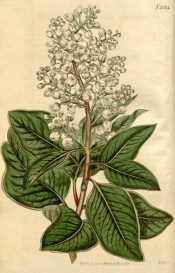Arbutus andrachne L.
Spreading, sometimes shrubby tree with smooth, peeling, red-brown bark and white flowers in erect panicles in spring, followed by spherical, warty, orange-red fruit, which ripen in the autumn of the following year. To 6m by 6m. [RHSE, Hortus, Hilliers’].
Horticultural & Botanical History
‘The most remarkable circumstance in this species is, that in the spring it sheds the old red bark, and the young bark is at first green, then turns whitish, and afterwards to different shades of brown, and finally, on the approach of winter, to a deep red. It is sufficiently hardy to bear the cold of our ordinary winters without shelter, but is liable to be much defaced, and in severe frosts to be quite killed. […] Cultivated in Dr. Sherard’s garden at Eltham in 1724.’ [BM t.2024/1818]. BR f.113/1816.
History at Camden Park
Listed in all published catalogues [T.62/1843] but also obtained from Kew Gardens, brought out from England by Captain P. P. King in 1849. Macarthur indicated that it was not new to the colony. [ML A1980-3].
Notes
Published Jan 04, 2009 - 10:16 AM | Last updated Mar 30, 2010 - 04:46 PM
| Family | Ericaceae |
|---|---|
| Category | |
| Region of origin | |
| Synonyms | |
| Common Name | Grecian strawberry tree |
| Name in the Camden Park Record | Arbutus Andrachne - Oriental arbutus |
| Confidence level | high |


